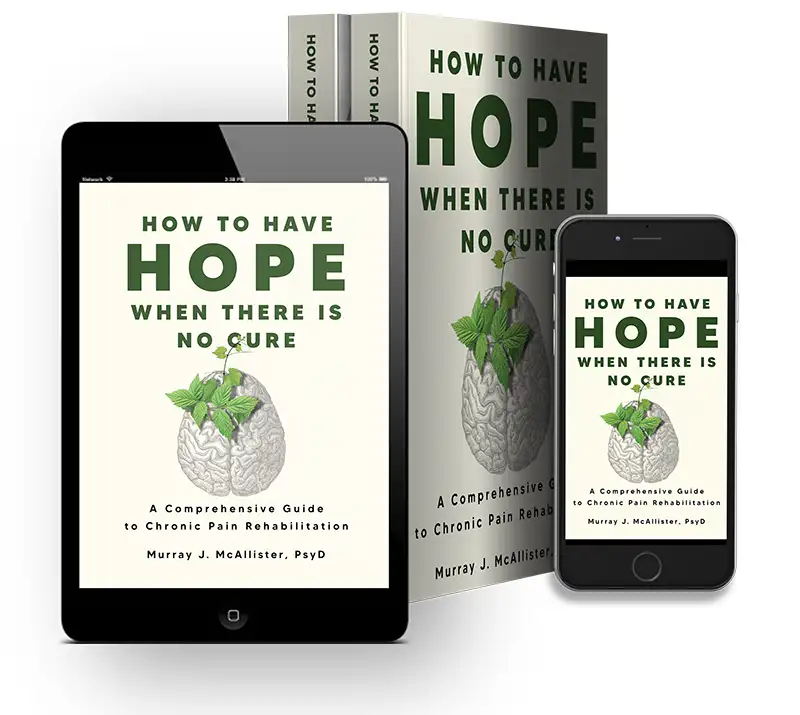
You can find the hardcover, paperback, and ebook versions here or wherever you buy your books
The Institute has provided those living with chronic pain, their family members and their providers evidence-based digestible information about chronic pain for over ten years. We are pleased to be publishing How to Have Hope When There Is No Cure: A Comprehensive Guide to Chronic Pain Rehabilitation. This groundbreaking book is the culmination of decades of work by our late founder, Dr. Murray J McAllister, PsyD, and serves as the pinnacle of our mission; to make pain management more effective by changing the culture of how chronic pain is treated. With the publication of this book, we will no longer be adding new content to our website or social channels, but current content will remain available.Murray J. McAllister, PsyD
Murray J. McAllister, PsyD, is a pain psychologist and consults to health systems on improving pain. He is the editor and founder of the Institute for Chronic Pain (ICP). The ICP is an educational and public policy think tank. In its mission is to lead the field in making pain management more empirically supported, the ICP provides academic quality information on chronic pain that is approachable to patients and their families.
Tolerance to Opioid Pain Medications
Patients with chronic pain, their healthcare providers, and society, more generally, are all typically concerned about addiction to opioid pain medications. This concern is well founded. Once commonly thought of as rare,1, 2 it is now generally accepted that the true rate of addiction to such medications is much higher than what was once thought.3, 4 The issue of addiction to prescription opioid pain medications generates considerable debate among the stakeholders in the field of chronic pain management. There are strong voices for the continued use of such medications despite the rate of addiction and strong voices against the continued use of these medications because of the rate of addiction.
Opioid-induced Hyperalgesia
What is opioid-induced hyperalgesia?
Algesia means pain. Hyper means over or above or heightened. Opioid-induced means caused by opioid pain medication.
We all have normal levels of heightened sensitivity to various stimuli. For example, you may have a favorite smell. Perhaps, it is cigar smoke because it fondly reminds you of your grandfather. A slight whiff of cigar smoke makes you think of your grandfather and gives you pleasant feelings. This experience is in response to a simple smell, which to others, leads to no such connotations. Or, perhaps, you have a favorite song. You may find yourself on an elevator and upon hearing the elevator music, you recognize the song and it feels good. No one else in the elevator even notices the song until you say, "Oh, that’s my favorite song." To take yet another example, you might be able to readily pick out your spouse in a large crowd and subsequently come to feel a sense of warmth and joy at simply your spouse’s presence. To others, however, your spouse may simply be an invisible stranger among others in the crowd. These kinds of normal sensitivity can be present in any and all of the senses, including touch, sight, smell, taste, and hearing.
Is it possible to manage pain well without opioids?
In chronic pain management, there are different types of pain clinics. Among others, there are two that seem almost diametrically opposed in their treatment of patients – even for patients with the same chronic pain conditions. One type of pain clinic is the chronic opioid management clinic. These types of clinics start chronic pain patients on opioids or take over the prescribing of the medications from other providers and subsequently maintain patients on chronic opioid management indefinitely. The other type of pain clinic is the interdisciplinary chronic pain rehabilitation program. They admit the same kinds of chronic pain patients and, instead of maintaining them on chronic opioid management, they taper opioids while teaching patients how to successfully self-manage pain.
Insomnia
What is insomnia?
Insomnia is a sleep problem that is marked by having difficulty falling asleep at the beginning of the night or returning to sleep upon awakening in the middle of the night.
Insomnia is common in persons with chronic pain. Upwards of half of all people with chronic low back pain, for instance, report insomnia.1, 2
Payers
In its current aims, the Institute for Chronic Pain promotes the theory and practice of chronic painrehabilitation. While far from the most profitable form of treatment, it is the most empirically supported. Moreover, a commitment to our guiding values ensures us to promote what, at the current time, is known to be the most efficacious treatment.
Providers
Our mission at the Insittute for Chronic Pain involves providing healthcare providers in the field of chronic pain management with the following:
Chronic low back pain affects about 10% of the population.1 Healthcare providers consider back pain as chronic when it lasts longer than six months and when they believe it will last indefinitely.
Neck Pain
What is neck pain?
Neck pain is one of the most common types of pain disorders in the general population. At any given time, 34-43% of the population report having neck pain. 14-22% percent of the general population report having chronic neck pain.1, 2 Healthcare providers consider pain to be chronic when it lasts longer than six months.
Complex Regional Pain Syndrome
What is complex regional pain syndrome?
Complex regional pain syndrome (CRPS) is an uncommon nerve-related pain condition. While it can occur in any body part, it usually occurs in an arm or leg. It has a typical set of signs and symptoms in the affected body part:
Chronic Fatigue Syndrome
What is chronic fatigue syndrome?
Chronic fatigue syndrome (CFS) is a condition of severe exhaustion that lasts for at least six months and which is not due to a known medical or psychological disorder. The exhaustion persists despite obtaining rest. CFS occurs in 0.46 to 1% of the general population and 80% of those with CFS are women.1
-
Opioid Tapering as an Exposure-based Therapy for Chronic Pain
“Thank you. I’m so grateful to all of you. You’ve given me my life back… but why did it take so long for me to be referred to this program?” This series of statements, along with the concluding question, is… -
What is Cognitive Behavioral Therapy for Pain?
Cognitive behavioral therapy is a traditional form of therapy that is used for a great many types of health conditions. Historically beginning in the 1970’s, it was first used as treatments for chronic pain and depression,1, 2 but later applied to… -
Why See a Psychologist for Pain?
People are sometimes surprised that there are psychologists who are not mental health providers. It’s also true for people with persistent pain who might wonder why their physician referred them to a psychologist for the management of pain. ‘I’m not… -
Whatever Happened to Backache?
You’d think that we’d all agree on what back pain is. Pain in the low back is almost as common as days of the week. Most everyone has had or will have back pain in the course of their lives… -
Should the Definition of Opioid Addiction Change?
Twenty some odd years ago, the American Academy of Pain Medicine and the American Pain Society, two large pain-related professional organizations, teamed up to agree upon what it means to have both chronic pain and be addicted to opioid pain…




